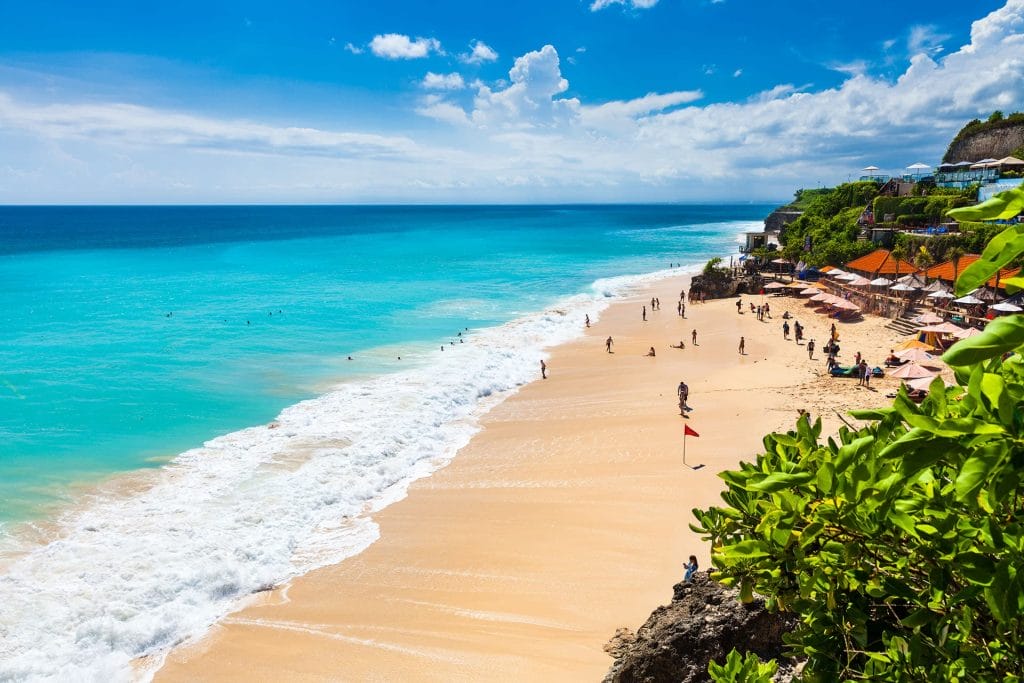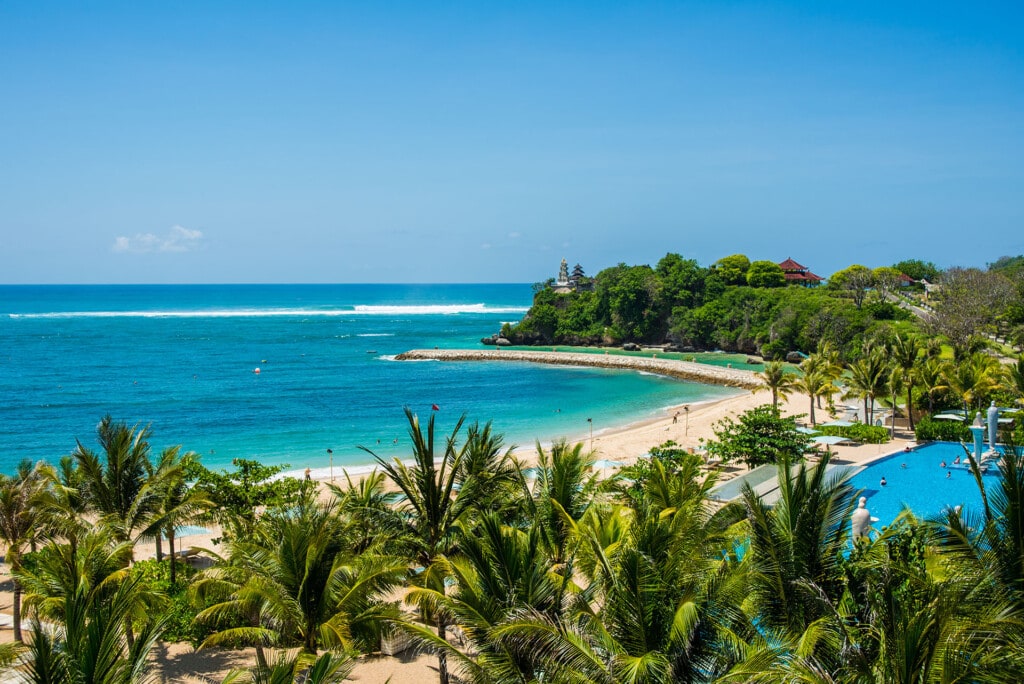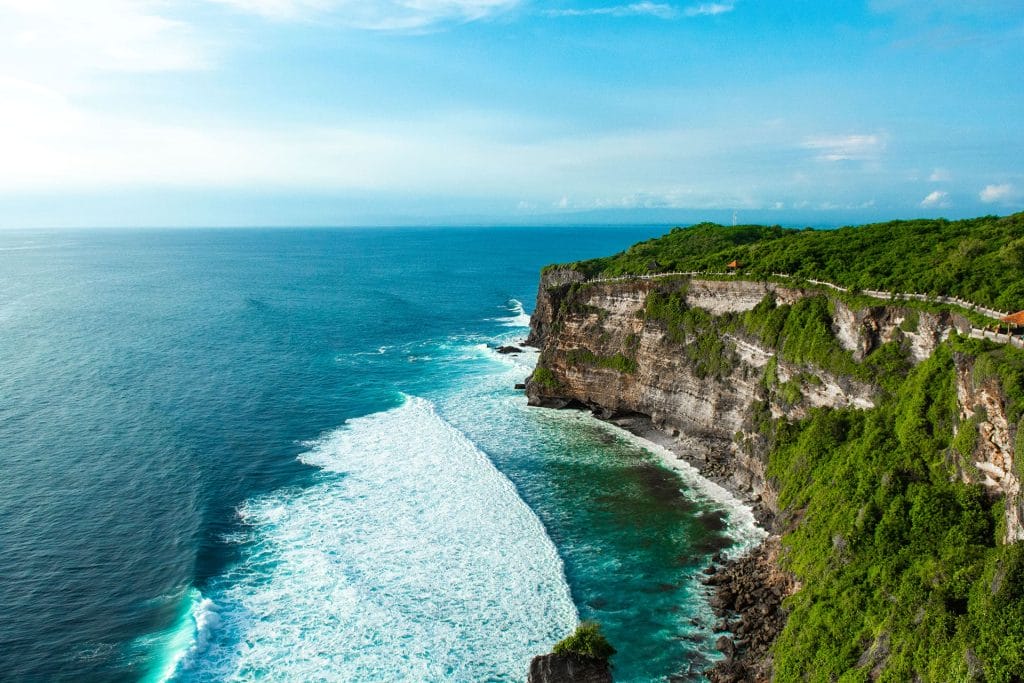Visiting Bali is on everyone’s bucket list, and with good reasons. This island packs everything you want from a perfect destination: culture, food, nature, and nightlife. This current Bali travel guide will help you navigate every important thing and plan the trip better, especially if you are unfamiliar with Balinese customs.
Why Should You Visit Bali?
Bali is a rich destination despite being a small island (compared to other major islands in Indonesia). Every traveler can find something they like here, thanks to the numerous attractions and recommended activities. You can visit temples, see art performances, do watersports, explore nature, enjoy delicious food, shop, and get immersed in its nightlife.
Bali also perfectly blends tradition and modernity. While it caters to international tourists, the locals still follow their traditional beliefs and preserve their traditions. From processions and temple rituals to traditional arts and performances, they open their doors to tourists while respecting their cultures and way of life.
If you travel to unwind and relieve stress, Bali is the perfect place. Known as a spa paradise, Bali offers spas and massages at different prices, depending on your budget. Bali is also a favorite location for yoga retreats. If you long to have your own Eat, Pray, Love adventure, you should start planning your visit!
Iconic Places to Visit in Bali
Where to go in Bali? It depends on what you look for. We recommend these places to explore, especially if you are a first-time traveler.
Ubud

Ubud is a destination for culture, wellness, and nature. You can find numerous spas here, from cheap ones to luxurious ones. Ubud has a lot of resorts and villas that offer relaxing views in the middle of nature. You can also find art galleries, sacred forests, yoga venues, and places to find delicious vegan food.
Kuta

Kuta is a surfer’s hub with a bustling atmosphere. Its beaches are often packed, but you can easily find surfing schools, including family-friendly ones. Kuta is also a favorite destination for travelers with limited budgets, with many options for motels, guest houses, and cheap local restaurants or food stalls. Kuta is also known as a “party central” popular among backpacker crowds.
Seminyak

For those seeking high-end establishments, Seminyak is a great choice. It is known for many posh, luxurious restaurants, nightclubs, and bars. Anyone who loves shopping can also find trendy shops and boutiques here. If you want to enjoy the sunset, head to one of its beach clubs and bars.
Nusa Dua

Another popular destination with high-end establishments, Nusa Dua, is known for beautiful resorts with private beaches, golf courts, restaurants, and luxurious spas. It also has watersport facilities, beautiful spots to enjoy the sunset, and luxurious wedding venues.
Uluwatu

Uluwatu is a favorite spot for more adventurous surfers, and most of its beaches are pristine and quiet. Uluwatu also has beautiful temples, including the famous Pura Luhur Uluwatu. You can also find exclusive restaurants and beautiful hotels or villas with magnificent views.
Sanur

The gateway of Nusa Penida Island, Sanur, is the place to see the local Bali charm. You can find a lot of local spas and massages, traditional food stalls, and a vibrant waterfront area without too much “party vibe.”
What to Do in Bali
This Bali travel guide does not encompass every possible activity you can do on the island. However, you can use these as recommendations to plan your itineraries, whether you stay for a long time or briefly.
Here are wonderful things you can do in Bali.
Head to the Spa
A spa is always the best way to pamper your body after a long flight or day full of activities. Almost all tourist destinations in Bali have spas, and decent three-star hotels and resorts usually offer spas and massages. However, Seminyak, Ubud, and Nusa Dua have some of the best spas on the island. From traditional Balinese treatments to holistic therapies, spas in Bali offer the best wellness experiences.
Visit Art Galleries and Museums
Bali is a home of wonderful artists, and many international artists are also known to find inspiration here. Museums and galleries in Bali offer traditional and modern arts and some even open short classes for tourists. From traditional arts to contemporary and even interactive ones, there will be no lack of artistic beauty to please your eyes.
Test Your Adrenaline
Bali tests the adrenaline of adventurous travelers with activities like rafting, parasailing, and bungee jumping. Nusa Dua and Lovina offer numerous watersports, including the ones that jumpstart your adrenaline. Ubud is known for its white rafting, which ranges from easy to difficult.
Have a Culinary Adventure
Bali is home to culinary feasts, and you can find anything: affordable and hearty local dishes, an international menu at posh restaurants, and delicious vegan foods. Balinese dishes like lawar, sate lilit, and ayam betutu are made with rich spices—Babi guling (roasted piglet) is succulent and a must-try. You can find these dishes at roadside stalls, mid-range restaurants, and posh establishments.
Visit Temples and Sacred Sites
Bali is known for its beautiful temples, and many of them allow tourists to explore. You can learn about their histories, what rites and ceremonies locals do there, or simply admire their beauty. Some temples offer beautiful scenery, while others hold performances for visitors.
Best Times to Visit Bali
April to October is the dry season, making it the perfect time to visit Bali. You can take better pictures and join most outdoor adventures, including whitewater rafting. However, June to August is peak season, thanks to school holidays. You can expect flight and hotel rates to be higher than usual.
November to May is the rainy season, which means a lot of rain during certain months (especially December to February). Not an ideal time to travel if you love outdoor experiences, but you can save money from lower hotel and flight rates. However, make sure you don’t book too close to December. Rates may increase again due to Christmas and New Year holidays, and there are few chances of getting the rooms and tickets you want.
How to Get There
Flight stays the number one method to get to Bali for international travelers.
If you are from Australia, Malaysia, Singapore, or New Zealand, you can find direct flights to Bali’s Ngurah Rai International Airport.
Suppose you are from anywhere in American, African, European, or Asian continents (aside from the ones mentioned). In that case, your international flights usually have transits in Singapore or Jakarta before arriving in Bali.
Getting Around
Bali offers several transportation options based on your budget and travel preferences.
Rental Motorcycles
Renting a motorcycle is a popular option among tourists and backpackers to explore various landscapes of Bali, from its most popular spots to beautiful rural areas. Motorcycles are also useful for navigating congested traffic, especially in areas like Denpasar, Kuta, Seminyak, Ubud, and Legian. Renting a motorcycle for a day only costs around US$5.
Grab
Grab is the Southeast Asian version of Uber. It is easy to install and provides options for car and motorcycle rides. The rate is quite affordable, and you can use other services with the app, like ordering food and buying phone credits or local mobile internet packages.
Rental Cars
Rental cars are convenient transportation modes for travelers who want extra comfort and privacy. Bali has numerous rental car services that offer vehicles with or without drivers. Renting cars with local drivers is often the best choice; you can enjoy your trip better, and the drivers often act as guides.
Rental fees vary depending on the durations, the size of the car, and whether you use a driver or not. However, the cheapest fee is usually around US$20 to US$30 for one day (not including gas).
Blue Bird Taxis
Most Bali travel guides recommend Blue Bird, known as “Bali Taxi,” if you want extra comfort. This iconic blue taxi has the most reliable reputation among foreign tourists in Bali. It is better to call their office to book or go to their counter at the airport. You can also ask the receptionist at your hotel to book it.
Please note that the routes for Blue Bird Taxis are limited in Ubud and South Bali.
Local Costs in Bali
Bali travel guide for backpackers differs from those splurging, including the local costs. While Bali is generally cheap, there are also options for mid-range and high budgets travelers. Knowing the average costs, you could expect for accommodation, transportation, food, and leisure activities can help you budget the trip better.
Here are standard local costs to expect when you are in Bali.
For Low-budget Travelers/Backpackers
Besides cheap accommodations like hostels, which cost US$10 to US$15 per night, depending on the location, you can spend just between US$25 to US$45 per day in Bali. These numbers include renting a motorcycle, scooter, or bicycle, eating at local food stalls, shopping at popular art markets like Kuta or Sanur, and entering free or cheap attractions.
For Mid-range Travelers
Accommodation options for mid-range travelers include decent hotels or three-rate resorts, which may cost around US$65 to US$150 per day. Otherwise, you can enjoy local food at mid-range restaurants or visit bars, cafes, and restaurants serving international menus. You can also rent a scooter or car for a day, get traditional massages at decent spas, and enjoy most attractions in the most popular destinations.
For Splurging Travelers
You can enjoy quite a luxurious holiday by spending at least US$250 to US$300 per day in Bali. With these minimum numbers, you can stay at a posh hotel or resort, visit high-end restaurants and bars, and access more options for attractions. You can also explore the more high-end areas, like Seminyak and Nusa Dua.
Where to Stay
Bali offers a wide range of accommodation types for different budget ranges. Consider these options before you find one that is the most comfortable and reasonable.
Hostels and Losmen
A hostel is a common option for low-budget travelers. Some hostels offer private rooms with basic services, while others look more like backpacker lodges, with shared rooms, kitchens, and communal spaces. There are also losmen, similar to simple inns with more homey or traditional vibes that are often family-run.
Homestays
Because of Bali’s popularity among tourists, many local families use the opportunity to earn a livelihood by opening homestays. A homestay generally means a family house that is converted into accommodation. Depending on the homestay, you may live with the family or in a separate part of the building.
Many Bali travel guides recommend homestays for more immersive experiences. You can experience a familiar warmth, connect with locals, and learn more about local customs and cultures. Homestay owners usually provide guests basic services, such as cooking meals or providing transportation. If you are lucky (or friendly enough), you can enjoy experiences such as learning to cook Balinese dishes with the family.
Guesthouses
Unlike homestays, guesthouses are more like house-like hotels run by families, similar to bed-and-breakfast. The atmosphere is usually homey and casual, with private bedrooms but a shared communal room, kitchen, and dining room. Most guesthouses may offer basic equipment like gas stoves, microwaves, rice cookers, and electric kettles, but you share the facility with other travelers, not the owner or their families.
Guesthouses are great options for low-cost accommodation with a homey vibe. They are perfect if you like interacting and getting friendly with other travelers.
Hotels
Bali has a lot of options for two-star to five-star hotels. However, most three-star hotels offer decent facilities and services, especially if you stay in more high-end areas like Nusa Dua and Seminyak. Some hotels are modern, while others bring Bali-inspired or nature vibes into the architecture, interiors, and amenities. Most hotels in Bali also offer spas and massages.
Villas
Villas are ideal for an exclusive stay in a spacious facility with in-house amenities. Some villas in Bali are parts of bigger resorts, while others stand as private buildings. Many villas have beautiful Bali-inspired interiors, with facilities like lush gardens and swimming pools. You can find villas in almost all major destinations in Bali, but Canggu, Seminyak, Ubud, Nusa Dua, and Kerobokan are known as the “villa destinations.”
Where to Eat
Even as a small island, Bali offers a myriad of options for a culinary adventure. Balinese dishes are rich in spices, but you can also find other local Indonesian dishes, thanks to the island’s diverse populations. However, international chefs and restaurant owners also bring their arts to Bali, adding to the island’s rich culinary scenes.
Cheap Food Stalls and Restaurants
Local, cheap food stalls usually come in the forms of warung and rumah makan (“RM”). Warung is often small, having semi-permanent structures or humble interiors. Meanwhile, rumah makan (lit. “eating house”) is like a small restaurant, with more permanent fixtures and a printed menu.
These establishments are the best if you want to try Bali’s authentic dishes. Combining local recipes, hearty portions, and rich spices make the meal more satisfying. You can find dishes like lawar (mixed vegetable and meat dish), ayam betutu (spiced chicken dish), sate lilit (satay made of ground meat), and babi guling (whole roasted pig).
In backpacker hubs like Kuta, you can find a lot of warung that sell nasi campur, a rice dish with side meals. They are savory and hearty; you can fill up your belly for less than US$2.
Mid-range Restaurants
If you have a little extra budget, mid-range restaurants give many more options. Aside from the local dishes, you can find international restaurants such as Thai, Italian, Indian, Japanese, and American. You can find anything like pizza, burgers, pad thai, sushi, butter chicken, and many more.
You can also find many mid-range vegan restaurants in various areas, from Denpasar to Ubud. Their menus are not limited to smoothie bowls and salads. You can find a lot of delicious vegan versions of local and international dishes.
Depending on the restaurant, a portion for one person and a beverage cost around US$7 to US$15.
Upscale Restaurants
Bali is home to upscale restaurants, both local and international. Many chefs with international achievements have made Bali their culinary grounds, such as Will Meyrick, Mandif Warokka, Eelke Plasmeijer, Ray Adriansyah, and Chris Salans. With an unlimited budget, you can have almost any culinary adventure here, including restaurants specializing in molecular gastronomy.
Depending on the restaurant, you can expect to shell out at least US$50 per person in those fine-dining restaurants.
Tips for Safer and Better Trip
Like any other destination in the world, Bali has unique customs and conditions that may be challenging or bewildering, especially for first-time visitors. Here are some common tips for a safer and better trip.
Mind the Offerings
Walking around, you will see little offerings like flowers placed on “bowls” made of coconut leaves. These offerings are called canang sari and are forms of gratitude to the gods among the local Hindu population. They can be placed on the steps, window sills, tables, doors, and many more.
Make sure to mind your steps, so you don’t accidentally damage them. You can take pictures, but don’t touch or disrespect the offerings.
Don’t Drink from Tap Water
Bali’s water is not potable, so avoid drinking directly from the tap. All accommodations provide drinking water from gallons, bottles, or jugs. Even if you boil it first, avoid using the water from the tap. Make sure the water is filtered first.
You can easily find mineral water in stores and supermarkets. However, it is wiser to bring your water bottle and fill it up before you head for adventure. Avoid drinking a cold beverage with ice cubes outside reputable, posh restaurants or bars.
Dress Properly at the Temples
When visiting temples, wear proper clothes even when the weather is hot. Avoid tank tops, tube tops, bikini tops, shorts, flip-flops, shabby outfits, and improper outfits for temples like t-shirts with alcohol brands. Temples usually provide sarongs or other coverings, but it is best to dress properly.
You don’t need to wear formal clothes, but the outfits should cover the shoulders, belly, thighs, and knees. Flip-flops are a no-no, but nice strap sandals or mountain sandals are usually okay.
Avoid Riding Bikes or Scooters if Inexperienced
Riding bikes or scooters should only be a choice if you have done it before (or if you are experienced). Riding in Bali is not just about the vehicle but also the road, traffic conditions, and other drivers’ habits. Renting a bicycle or using a rider app like Grab for a short distance is a better option.
Know the Closest Important Places
Once you arrive at your accommodation, find the closest clinic, hospital, and police station. Ask the staff for important numbers and save them on your phone, making sure they are easy to access.
Mind the Mosquitoes
Bali’s climate makes it a haven for mosquitos, and Indonesia is an endemic country for dengue fever. Make sure you prepare extra, especially if you head to places surrounded by trees and shrubs or rural areas. Bring mosquito repellent cream and spray, and turn on the fan or draw the bed mosquito curtain if there is any.
Keep Your Drinking Safe
If you drink, make sure to drink only at established bars or reputable places. Mind the type of local alcohol called arak sold at dubious stalls or local drinking holes. Arak at these places is often mixed without proper measurement, which can result in methanol poisoning.
Double-check Your Villa Reviews
Staying at private villas can be an exclusive experience, but the security can be a bit lax compared to decent hotels. There have been cases of robberies, and fellow tourists even conducted some. Aside from not leaving your valuables, always check the real reviews from others and see if there are dubious or unpleasant histories.
Bali is a tropical paradise where you can find something different for your taste, from culture to culinary and outdoor adventure. Use this Bali travel guide as a starting point to ensure a fun, safe adventure!







